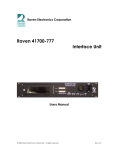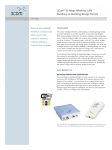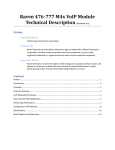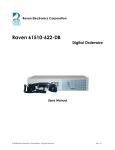Download M4x VoIP Blade Quick Start Guide
Transcript
www.ravencomm.com M4x VoIP Blade Quick Start Guide Thank you for purchasing the M4x Blade. LED Indicators There are seventeen LED indicators on the front panel of the M4x Blade as shown in Figure 2. When unpacking your M4x Blade confirm the following items were received with your shipment. There are two LEDs per Port. The first LED is Red (default is XMT (Output)). The second LED is Green (default is RCV (Input)). Software CD This CD also includes the User Manual AC Power Supply Adapter 120/240 VAC, 12 VDC 2.5 Amp regulated (Note: on units powered from a DC source, this item will not be included) There is a Power On LED which is also Green to let the user know the M4x Blade is powered on. Power Cord (Note: on units powered from a DC source, this item will not be included) USB Cable Figure 2 If any of these items are missing, please contact Sales at 775-858-2400, press 2. For more details regarding how the LEDs can be set to indicate PTT (E-Lead) or COR (M-Lead), please refer to the M4x User Manual. Installing The M4x Software Note: Install this software before plugging in the M4x Blade. M4x Port Pin-Outs 1. Uninstall old M4x Software before installing a new version. 2. Install the software by inserting the CD into the computer’s CD drive. 3. We recommend selecting “Easy Install” when prompted. 4. Follow the on-screen prompts to complete the installation. 5. Refer to the M4x User Manual included on the software disk for more detailed installation instructions, (especially if this version of software will be installed over a prior version of software). On top of the M4x Blade, there is a label with pin out information for each port installed in the M4x Blade. Please note, the pin order is grouped for clarity. 12345678 Note: E-Lead is PTT, M-Lead is COR Powering Up the M4x Blade WWW.RAVENCOMM.COM 1. Connect the Power Cable into the AC Power Adapter. 2. Connect the AC Power Adapter to your AC power source (e.g. 3-pronged grounded wall outlet). The AC Power Adapter can be connected to a 100 to 240 VAC, 50-60 Hz, 0.5A source. 3. MODULE 476-150 Connect the DC plug from the AC Power Adapter into the DC jack on the rear of the M4x Blade as shown in Figure 1. DC Jack USB Port Figure 1 PIN PIN PIN PIN 1 2 3 6 PIN PIN PIN PIN 4 5 7 8 RCV M-LEAD XMT E-LEAD 4-WIRE INTERFACE PIN PIN PIN PIN 1 2 3 6 PIN PIN PIN PIN 4 5 7 8 RCV M-LEAD XMT E-LEAD MODULE 476-151 PIN PIN PIN PIN 1 2 3 6 PIN PIN PIN PIN 4 5 7 8 RCV M-LEAD XMT E-LEAD 4-WIRE INTERFACE PIN PIN PIN PIN 1 2 3 6 PIN PIN PIN PIN 4 5 7 8 RCV M-LEAD XMT E-LEAD MODULE 476-777 PIN 1 PIN 2 PIN 3 PIN 6 PIN 4 PIN 5 PIN 7 PIN 8 ETH XMT ETH RCV ETH SHLD ETH SHLD VOIP PIN 1 PIN 2 PIN 3 PIN 6 PIN 4 PIN 5 PIN 7 PIN 8 4W RCV M-LEAD 4W XMT/2W E-LEAD Thank you for choosing a Raven Electronics M4x Blade for your Communication needs, where we are the idea shop committed to solving engineering problems and exceeding expectations. Rev: B 2011 Raven Electronics Corporation 4655 Longley Lane, Reno, NV 89502 Main: 775.858.2400 Sales: Press 2 Technical Support: Press 3 Fax: 775.858.2410 9. Configuring the M4x VoIP Module Be sure to enable the session and press Submit. 10. The session highlighted will be lit green (as shown above) when the connection is established and working. 1. Click on the “Raven VoIP” on the system components window and the Port Status box will appear as shown in Figure 3. As with the Analog 4-Wire Module, you may change the name. Figure 3 2. 3. Press settings and a larger box will appear with various tabs to choose from. On this first tab, labeled Description, is where the “Raven VoIP” description can be changed to whatever the user or programmer would prefer. Figure 6 Status Indicators Next press on the tab labeled “Interface Settings” as shown in Figure 4. This is where the local IP Addressing parameters are set for this Blade. It is recommended to use a Static IP Address (the default). Press the “Set” button when finished. 1. To see the status of the VoIP Link, click on the “+” next to “Raven VoIP” on the system component window. 2. Click on the first VoIP Port (and second, if set up.) 3. This shows an example of the Raven VoIP Port 1 Receiving (RCV) and Raven VoIP Port 2 Transmitting (XMT) a VoIP stream. Shown here with a Green Light lit next to VoIP RCV on the Port 1 status screen and a Red Light lit next to VoIP XMT on the Port 2 status screen. This shows the status of the VoIP connection and that communication is occurring. Figure 4 4. “VoIP Type” is the next Tab to click as shown in Figure 5. This allows the user to choose different modes of operation. Most applications use Multi-Point Unicast (the default). Figure 5 5. 6. Figure 7 Configuring a Bridge 1. Configure the M4x Analog 4-Wire Module(s) before configuring a Bridge. 2. The M4x Blade allows multiple bridge configurations to be created on one blade. 3. Click “System Bridging” on the right side of the screen. 4. Drag various ports from the system components panel and drop them onto the Port Name boxes in the Bridge Configuration pop up box. Now go to the Unicast Setup tab as shown in Figure 6. This is where the VoIP Configuration takes place. If Broadcast is NOT checked, the associated bridge group will be full conference. Position the mouse over a Port (an Analog Port previously configured on the system components window). Drag the Port into the screen above. Repeat to include the Ports required to be backhauled. 7. Set the IP Address to match the host endpoint to communicate with (located under Peer) 8. It is recommended to use the defaults for the RTP (Real Time Protocol) RX Port and TX Port. Raven Electronics Corporation 4655 Longley Lane, Reno, NV 89502 If DTMF Bridge Group is enabled, the members of the bridge are now able to be cross-patched dynamically as remote users dial using DTMFenabled devices. Please refer to the M4x User Manual for more detailed settings. 5. Click the check box “Enabled” to enable the bridge. Main: 775.858.2400 Sales: Press 2 Technical Support: Press 3 Fax: 775.858.2410












